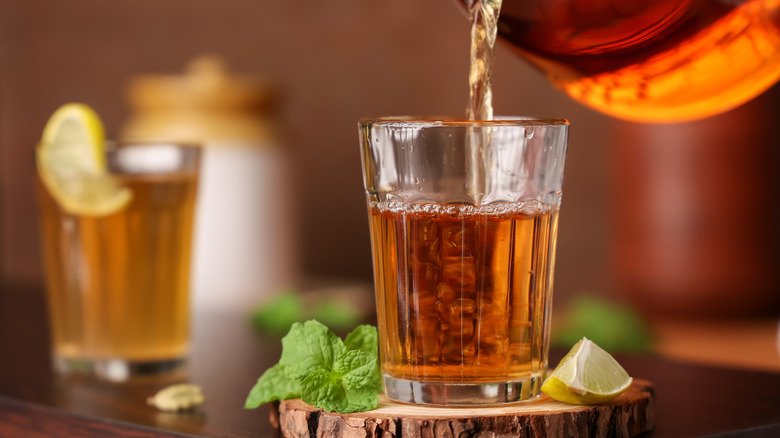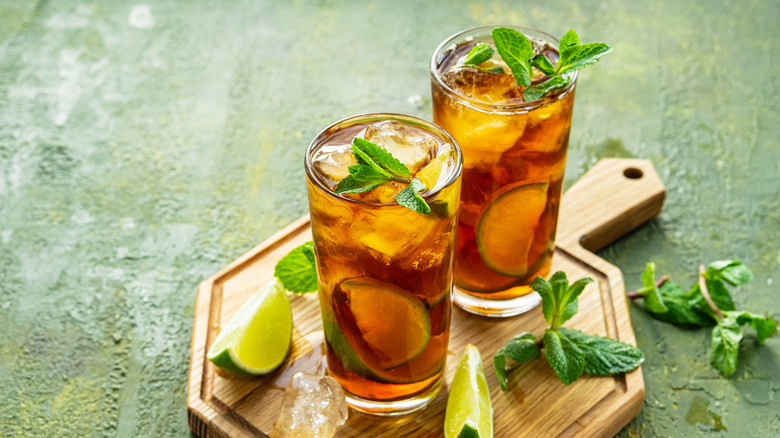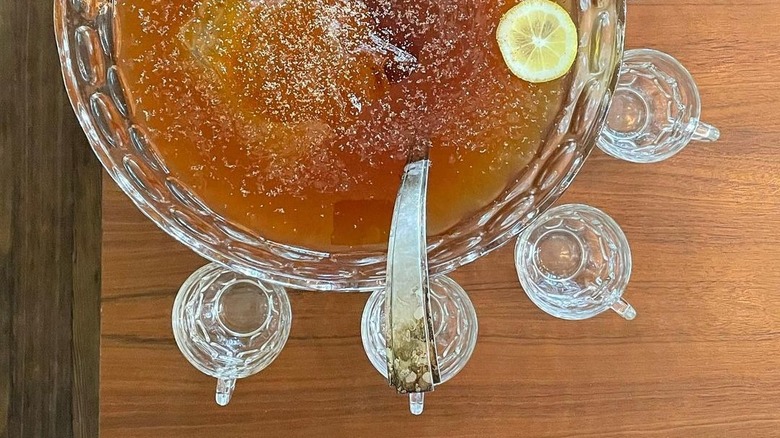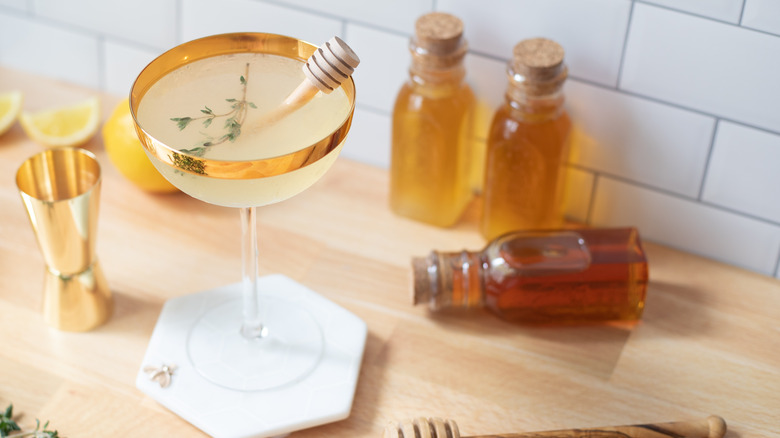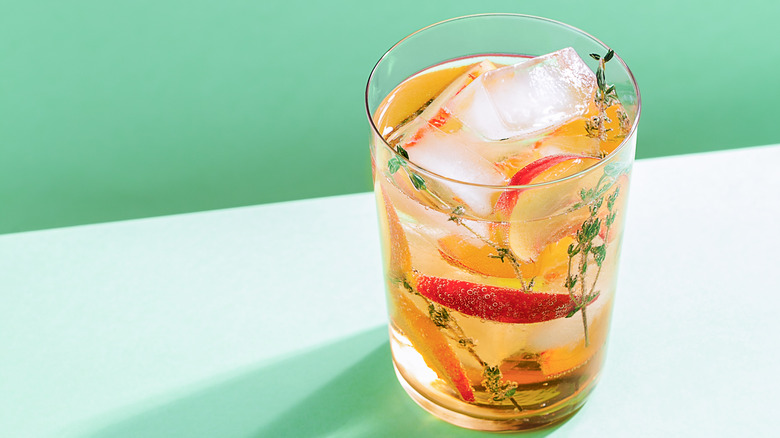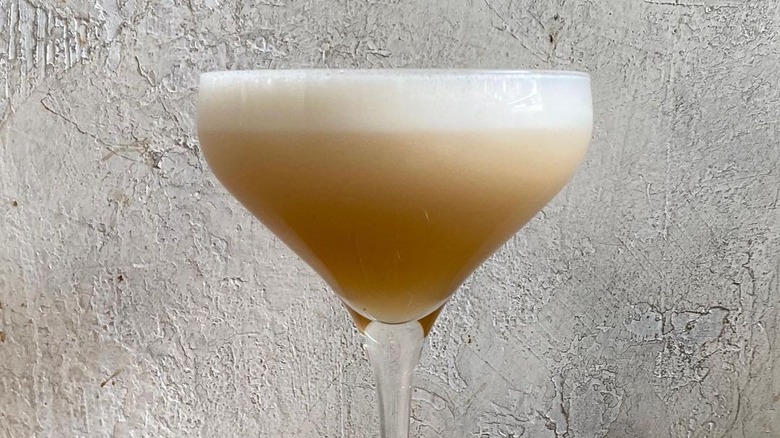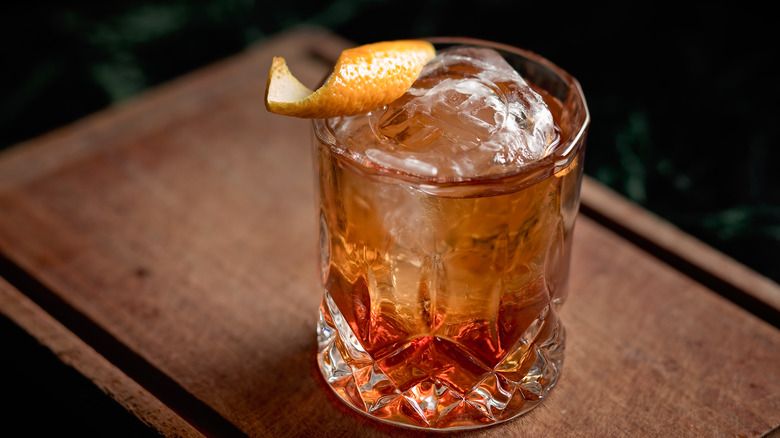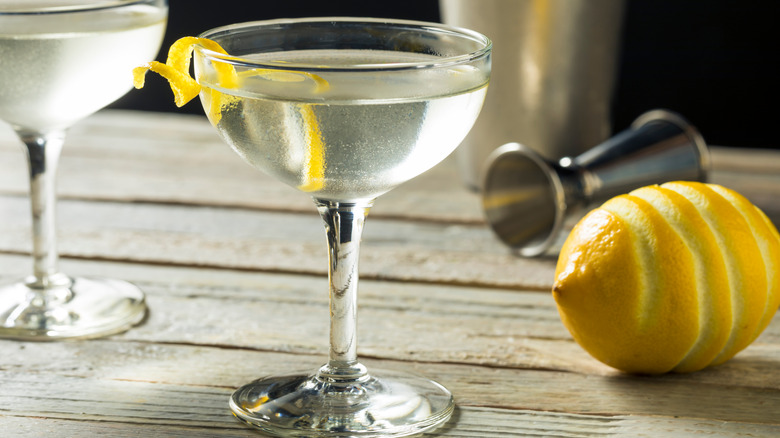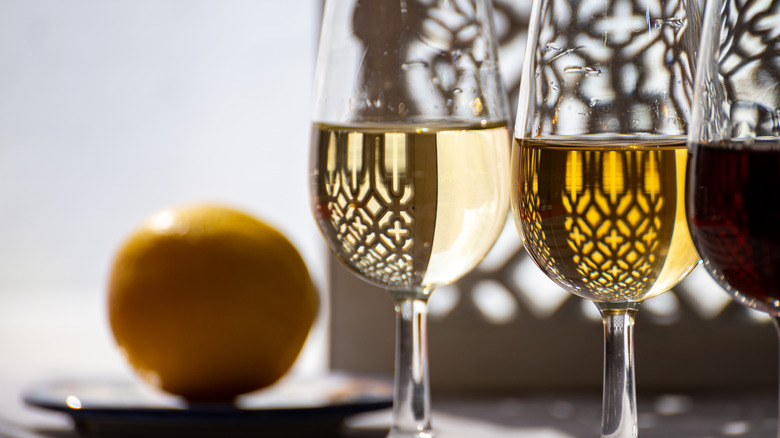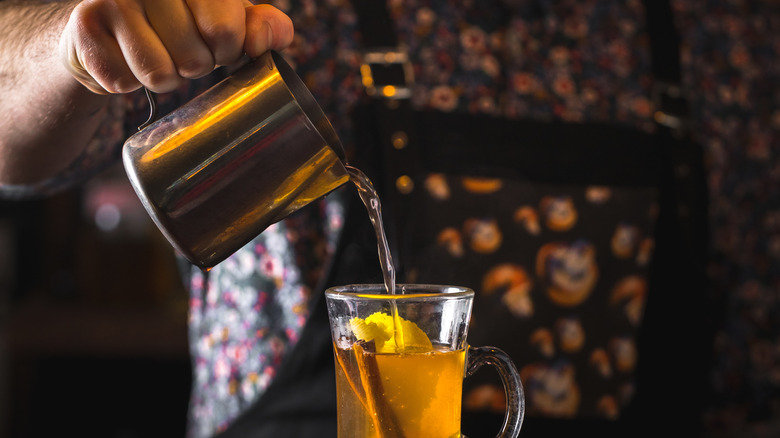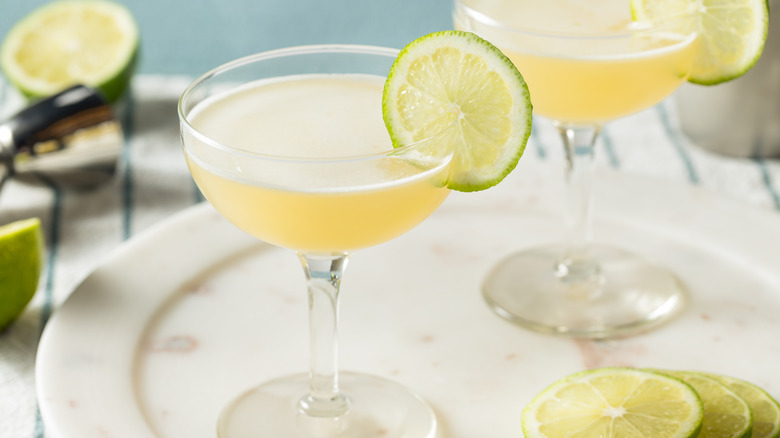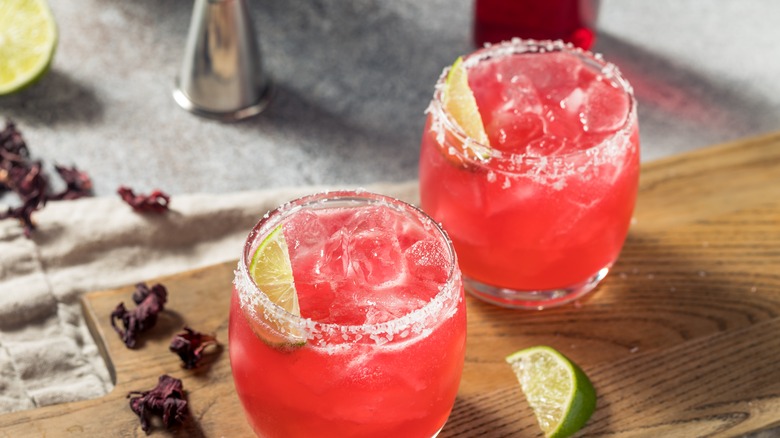11 Tea-Infused Cocktails For Any Occasion
When cocktail hour rolls around, your first instinct probably isn't to reach for a bag of Earl Grey. Mixing tea and booze, however, is not some trendy new gimmick. It's a tradition that dates back to the Colonial era, when tea was mixed with alcohol and served over ice — a precursor, even, to the ubiquitous non-alcoholic iced tea of today (via NPR). To explore the modern landscape of tea cocktails, Tasting Table sat down with Ryan Polhemus, the bar director of Boston's Offsuit. We discussed where tea-infused cocktails come from, why they work, and where they're going.
"I think there's a general shift in drinkers' palates toward dryer drinks and more complex, adventurous flavors," said Polhemus. "How many times have you heard someone order a drink at a bar and follow it up with 'not too sweet, ok?' Tea presents a perfect solution, and I think we'll be seeing a lot more of it in the future." Whether Polhemus is right in the long run remains to be seen. But in the meantime, try your hand at one of these delicious tea cocktails and see what all the fuss is about.
Rum punch
To understand how different tea types and blends fit into cocktails, we have to first explore where the notion of modern cocktails really started. According to Difford's Guide, it's safe to say that "punch" was the earliest, most rudimentary forebearer of what we consider a cocktail today. "There's a classic Caribbean punch rhyme," says Polhemus. "'One of sour, two of sweet, three of strong, four of weak.' The 'strong' element was obviously hooch, and the 'weak' ingredient was often tea, which was bought and sold along with rum along trade routes all over the world."
By including tea in their rum punches, imbibers of old would introduce tannins, an important counterbalance to the drink's sweetness. "The natural tannins in tea are a great way to offset the sugar and add another layer of complexity to a cocktail," says Polhemus. "It also tastes pretty good."
There's no official, universally agreed upon recipe for rum punch. However, Punchfork's recipe for Sweet Tea Rum Punch is one that checks all the boxes for us (and obeys that famous rhyme): rum, sugar, citrus, spice, and tea. Don't be afraid to fiddle with recipes or ratios of your own. Punch does often come in a bowl, after all, so there should always be room for a little experimentation.
Philadelphia Fish House Punch
Polhemus has been making drinks for years and like many bartenders, he's turned to historical sources of inspiration for his next cocktail creation. "Tea features in recipes that predate the Declaration of Independence," he points out, "and it's found its way into modern drinks through both original recipes and re-imagined classics." One of his favorites? The Philadelphia Fish House Punch, an early American invention that came about thanks to some boozy Quakers in Pennsylvania. "It's the granddaddy of tea-infused drinks, and a well-made one will convert even the most skeptical sipper."
According to David Wondrich, author of the historic cocktail book "Punch" and a writer at Liquor.com, Philadelphia Fish House Punch was first invented in 1732 when a group of rich Philadelphians leased some land from the Lenni-Lenape tribe and declared themselves the independent Colony of Schuylkill. It was there that they built their social club — nicknamed the "Fish House" thanks to their primary means of trade — and started the long and rich tradition of fishing, barbecuing, and getting totally sloshed.
The early Fish House punch recipe survived the interceding centuries, and today you can get a taste of history by trying Difford's Guide's version of the drink, which calls for cognac, rum, peach liqueur, sugar, citrus, and — you guessed it — black tea.
Bee's Knees
According to Sweet Tea and Thyme, the Bee's Knees cocktail dates back to the Prohibition era. The exact origins of the drink are up for debate, with some accounts crediting its invention to the Titanic's famous "Unsinkable" Molly Brown. Whether or not that's true, this much is certain — the Bee's Knees lives up to its name, and then some.
Traditionally, the cocktail calls for gin, lemon, and honey. Polhemus says this makes it an ideal candidate for introducing tea. "Pairing tea with cocktails shouldn't be too complicated. Start with flavors that complement the tea you're using. A Bee's Knees already contains honey and lemon, so adding your favorite green or black tea to the mix is a natural progression."
If you want to get extra experimental, try Burrata and Bubbles' Chai Bee's Knees, a riff on the classic cocktail that introduces a warming spice component to the traditionally bright, citrus-forward drink.
Gin and tea
Short on mixers? Out of your favorite liqueur? Or maybe you're looking for elegance in simplicity. "One of the best things about infusing tea into a cocktail is how utterly easy it is," says Polhemus. "If you can make a cup of tea and you can shake a cocktail, you've got all the skills you need." A gin and tea can range from something as simple as leaving a teabag to steep in a glass of gin to making pre-steeped tea that's left to cool and then mixed with gin and tonic, gin and lemon, or some combination of the three.
Infusing a botanical spirit like gin with tea allows the often juniper-forward characteristics of the booze to play off secondary and tertiary flavors in the tea. Experiment with Earl Grey, chamomile, lavender, or hibiscus to start. Tonic plays especially well with the latter, as in Thomas Henry's gin and tea recipe.
Tea Time
Polhemus cites the Tea Time cocktail as an invention of Dave Arnold, author and esteemed bar scientist behind the book "Liquid Intelligence" (via Instagram). Arnold featured a drink called "Tea Time" at his New York City bar Booker & Dax, an experimental cocktail spot whose zany concoctions delighted and surprised Manhattan drinkers for five years before its closure in 2016 (via Grub Street).
"On the surface, the Tea Time was just a boozy Arnold Palmer, but in addition to a supercharged infusion with Darjeeling tea, it utilized a technique called milk-washing, in which a cocktail is clarified through milk curds," Polhemus explains. "There's a bit of science involved. Dave used a centrifuge to achieve the milk-washing effect, though you don't need one. The protein in the milk binds with the tannins in the tea to mellow the bitterness of the long steeping."
If you want to see just how the drink was made, check out Dave Arnold's video. For those at-home mixologists who are short a centrifuge, try Punch's "Tee Time" iteration of Dave's recipe, which allows for straining the liquid through a coffee filter to achieve the desired effect.
Old Fashioned
Some classics are so traditionally immutable it may seem like sacrilege to futz with them. As the old adage goes: If it ain't broke, don't fix it. But Polhemus insists that certain stirred cocktails — the Old Fashioned, for instance — are reasonable candidates for some tea experimentation. "I think drinks like the Old Fashioned can benefit from a little bitterness," he says. "A tea-infused simple syrup goes a long way toward preventing a cloying cocktail."
Tea syrups are easy enough to make. It's the same recipe as making regular simple syrup, except instead of using sugar and hot water, you'll use sugar and tea. Brew a cup or pot of tea as normal, add an equal amount of sugar, stir until fully integrated, and voila (via Liquor).
Try Cocktail Contessa's Earl Grey Old Fashioned recipe if you're looking to jazz up one of the classics — it's simple to make, yet packed with flavor and nuance. A nice pre- or post-dinner party trick the next time you've got whiskey drinkers over.
Earl Grey martini
If you like your gin and tea cocktail, the next step up is a tea martini. According to Liquor.com, tea martinis are best served with a London dry style gin, which can be infused with Earl Grey tea leaves and then used in a classic stirred martini. The website recommends switching to a navy strength gin if you're hoping for a faster infusion. Together, the tannin of the tea and the verve of the gin can make for an icy, biting cocktail. Try mellowing it out by adding egg whites to smooth the texture and enrich the cocktail's flavor.
You can also turn the martini into a sour by adding a splash of citrus, as is the case in Audrey Saunders's recipe for an Earl Grey martini. The dose of citrus helps pucker up the drink, lending a tart sheen to the otherwise tannic cocktail.
Oh, and if you're nervous about completing your own infusions, don't sweat it. Just put four tablespoons of your tea of choice into a standard 750ml bottle, and let sit for several hours. Strain, rinse the bottle, refill with your newly infused spirits, and you've got a homemade tea gin ready to go for your next tea-infused cocktail (via Punch).
Tea and sherry cocktails
One of Ryan Polhemus's original inventions, which he serves at the Boston speakeasy cocktail bar Offsuit, is called Trick of the Light. "Not to toot my own horn," he says, "but I make a pretty good tea cocktail at my bar. It pairs green tea and seaweed with gin, sherry, and honeydew in a drink that ends up tasting suspiciously like adult Mountain Dew." This isn't the kind of cocktail you might just happen to whip up at home, but it does provide inspiration for a more accessible at-home cocktail duo: tea and sherry.
You may be thinking: Sherry? That's the stuff that grandparents drink. Heck, you might feel that way about tea, too. But light, salty styles of sherry-like fino or manzanilla are far cries from the cloyingly sweet cheap sherry you might've sniffed as a kid. And the truth is, they're great to drink on their own or use in a cocktail.
According to Self.com, there's a tea-infused sherry cocktail called the Sanlucar Sipper which was invented by Rick Pitcher, then-beverage director of the now defunct Gander in New York City. The cocktail is almost like an Italian take on a classic punch recipe, with Aperol standing in for the heavier spirits and sherry taking the place of the liqueur. The drink is rounded out with grapefruit, lemon juice, sugar, and black tea.
Hot Toddy with tea
You didn't think we'd leave out a classic winter warmer, did you? The Hot Toddy is a perennial favorite for when the weather starts to turn and "throwing back a cold one" just doesn't have the same appeal. It is traditionally made using a base liqueur — like whiskey or brandy — that is supplemented with hot water, lemon, and sugar (or honey). You can fancy up your Toddy with cloves of cinnamon or whatever other warming spices you want, but the base recipe only calls for the booze, water, citrus, and sweetener.
But you can level up this classic cocktail by replacing the hot water was a cup of tea. The tea adds texture and tannins, helping the booze integrate with the citrus and sugar. If you're looking to try your hand at this cocktail, first decide if you're using black or green tea. Then, add either whiskey, brandy, or rum as the base spirit. Hot seasonal cocktails are a special kind of treat. Try yours with tea — you won't regret it.
Green tea vodka gimlet
Traditionally, vodka is one of the best options for liquor infusions. It's normally a neutral spirit, meaning it has no discernible flavor of its own. (Recent trends and changes in the official definition have blurred vodka's adherence to flavor neutrality, but that's a topic for a different day.) The next time you're in the mood for a stiff vodka cocktail, try infusing a bottle of the stuff with green tea by adding several tablespoons to a 750ml bottle and letting sit for a few hours. Strain through a coffee filter into a clean receptacle, and you're ready to rock.
Once you've got your infused spirit, fix yourself a green tea gimlet by pouring equal parts vodka and lime juice over ice, stirring well, and straining it into a chilled glass (via Life Is Better With Tea). If vodka isn't your thing, gin will work just as well. Just make sure not to get something too overly botanical or it'll clash with the green tea's flavors. If you want to dress up your cocktail, try adding a sprig of mint, a wedge of lime, or both!
Hibiscus margarita
Hibiscus seems to be everywhere these days. Whether it's in an iced pink drink at your local coffee shop or in a boozy concoction at the bar, this ingredient is all the rage and seemingly here to stay. Food 52 features a recipe that uses two cups of dried hibiscus flowers to make a sugary tea that's then combined with traditional margarita ingredients to make a slightly heftier, more concentrated take on the traditional cocktail.
You can also save some of the hibiscus tea (or syrup) and refrigerate it for later use with other spirits. Hibiscus' floral qualities make it read more like a regular mixing syrup than a tannic tea, meaning you can use it to gussy up a variety of different cocktails. Give it a shot with the gin-based French 75 or even a brown liquor drink like a whiskey sour.
Hibiscus is much less tea-ish than something like Earl Grey or English Breakfast, so if you've got a friend on the fence about tea and alcohol, start 'em out with this.
